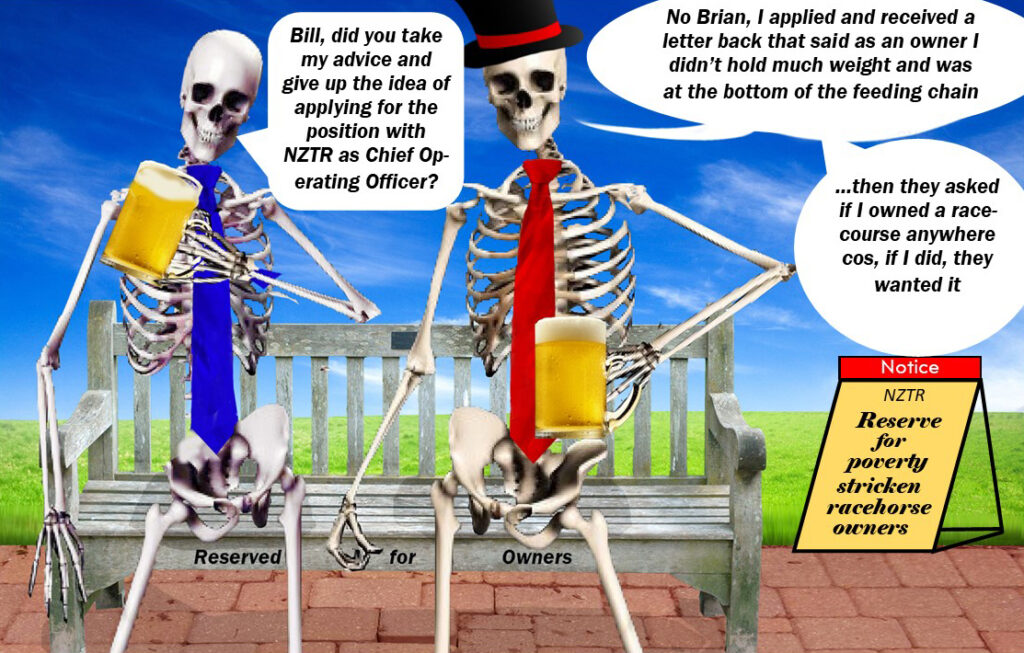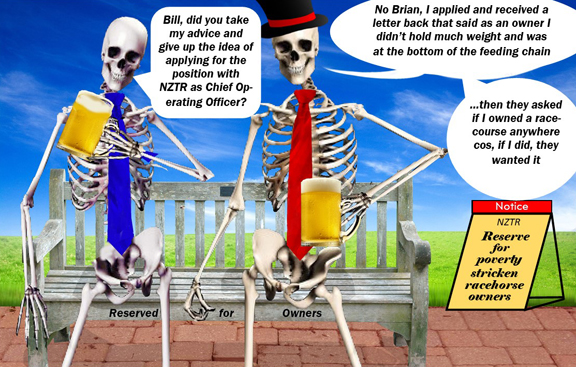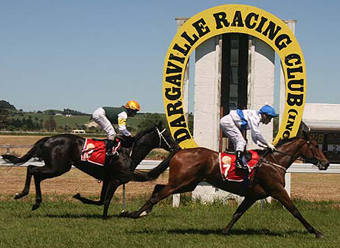by Brian de Lore
Published July 4th 2021
The willingness of TAB NZ to pull the wool over the eyes of the racing public became evident once again on Friday when it released a media statement claiming the credit for $30 million of income derived, not from the TAB, but the 2020 legislation.
The $30 million is made up $20 million from ‘racefields’ or BIUC (Betting Information User Charges) and $10 million from the repeal of the two percent betting levy – two of the 17 Messara Review recommendations written into the racing Act of 2020, and nothing whatsoever to do with the TAB.
The TAB’s announcement that budgeted distributions to the racing codes for the upcoming 2021/22 season will be 23 percent higher than the $117 million budgeted distributions for the current season is laughable.
$117 million budget was low-ball because of COVID19
The $117m set by the TAB for the current season was a low-ball budgeted figure set when there were significant uncertainties for the future of New Zealand’s wagering and gaming businesses because of COVID-19.
So, this budget for the current season is $33 million below what is required to fund the codes to enable them to maintain stakes at the pre-COVID level and the anticipated TAB betting profits for the current season.
All this smoke and mirrors carry-on was part of the Glenda Hughes-John Allen publicity machine under NZRB, and now with a name change to TAB NZ and under the Chief Transitional Officer Dean McKenzie, nothing has changed.
The chasm between reality and the fanciful world of Dean McKenzie is wider than the Grand Canyon. The participants of racing have only ever wanted to know the truth handed out by someone who is genuinely working in their interests – not some overpaid, self-serving egotist of the type we have seen succeed each other for the past decade.
In the media release, McKenzie said: “It’s great that we’re in a position to increase our returns…we’re now seeing the positive returns from the investment made by the Government and the industry in the TAB. We’re excited with where we are heading and incredibly proud that significant tangible benefits….”
He’s excited, is there anyone in the real world excited?
Under last year’s legislation, the devolvement of many areas of responsibility from NZRB/RITA/TAB NZ to the racing codes has not happened because the three codes have not come together, as the legislation provided for, to draw up a commercial agreement for the negotiation of distributions into the codes, etc..
Bringing in the Racing New Zealand board was new to the legislation, and invented explicitly to: “act as a consultive forum for the racing codes, and to represent the racing codes in relation to negotiations, interactions with other bodies under this Act, and other matters, with the agreement of the racing codes.”
However, Racing New Zealand cannot function effectively because it hasn’t been appropriately appointed. It’s supposed to have one person from each of the codes and two independents. But the two independents haven’t been appointed, and the codes have been running it on a please themselves basis in the first year by taking along the three CEOs – Saundry, Woodham, and Hughes – none of those three are supposed to be involved and shouldn’t be involved.
It’s all very well having newish, one-year-old legislation in place, but when you have an industry that deliberately ignores bits and pieces to suit itself, it’s no different to them claiming they’re doing the Messara Review when, in fact, it’s only cherry-picking the low hanging fruit and leaving out the vital clauses.
Some of our leaders haven’t even read the legislation
Having spoken to some of the decision-makers at various times, would it surprise that some haven’t even read the legislation, and if they have, have only skimmed over it and don’t get it. Not that we wouldn’t mind altering the 59 clauses that require Ministerial stamp of approval to do anything – knowing we have a Minister very short on industry knowledge (and appearances) and advised by non-specified interested parties.
Racing remains in a mess. NZTR has been weak and has seen a deterioration in its relationship with racing people trying to stay active in the game. NZTR CEO Bernard Saundry refers to them as customers, but he isn’t running a corporation; in reality, he‘s their employee and should support them and develop initiatives to keep people active in racing and breeding. The foal crop numbers prove that’s not happening.
Where’s the future plan? It’s July 4th, and as I write this we have no funding model for the clubs for the season starting August 1st. On Weigh In when last interviewed, Saundry suggested prizemoney increases for the middle and top races, and the bottom level had their turn three years ago. Why didn’t he just kick 90 percent of owners in the guts there and then?
NZTR puts pressure on Dargaville for $800,000 to $1 million
Arrogance on NZTR surfaces regularly. Consider the plight of the Dargaville Racing Club and the stand-off that now exists as NZTR tries to enforce Clause 25 of the Racing Act 2020, which specifically addresses the ‘Transfer of surplus venue by agreement.’
NZTR has its hand out for 40 percent of the value of the Dargaville Racecourse, which is valued at somewhere between $2 to $2.5 million. Dargaville is an isolated outpost over an hour by car west of Ruakaka. It had one annual community-driven race day but hasn’t had a date allocated for four years. The club resisted taking their race date to Ruakaka as the sponsors and local community said they would not support it.
The Dargaville committee has accepted that the decline in racing would lead to track closures, but the pill they haven’t been able to swallow came when NZTR wrote to the committee to inform them no further racing would be staged at Dargaville with an offer to help sell the racecourse to put the money into other racecourses.
The club has owned the land in an unencumbered title since it was donated to them by a local family named Findlayson about 100 years ago. Since then, volunteer committees have run the racing with all upkeep on the course done through working bees. Not one cent has ever come from NZTR to assist in its maintenance. Some committee members have served for 30 volunteer years, so anyone with a sense of fairness will understand the resistance.
Shane Jones and Winston Peters at odds on the future of Dargaville
The irony of the Dargaville stand-off is the NZ First left hand not knowing what the NZ First right is doing. Almost simultaneously, Winston Peters signed off on the legislation for the ‘land grab,’ as NZ First’s Provincial Growth Fund Manager, Shane Jones, allocated the Dargaville community $900,000 to develop the racecourse for the benefit of the community.
Dargaville is on the point of gaining approval for a retirement village and housing development to benefit the locals, and rightly say the grant or the land value won’t be used to benefit NZTR, and nor it should.
In a letter to Dargaville from Bernard Saundry, dated June 25th, in part he stated: “As a starting position, we would propose that 20% of the proceeds be allocated to support racing in the northern region, 20% be allocated to NZTR for stakes and other purposes, and the balance (60%) settled on a community trust as the Club has previously proposed.
“I must also warn you that NZTR’s patience in relation to this matter is close to exhausted. We wish, as does the Minister, to see an industry-led negotiated resolution to the future of the Dargaville Racecourse. However, if the Club continues to fail to engage reasonably with NZTR by refusing to provide the information NZTR has requested, or to continues to avoid negotiating in good faith with NZTR, or otherwise act in a way which gives rise to concerns about the Club’s governance and management, we will be left with no choice but to consider other options to bring this matter to a close, such as exercising NZTR’s statutory power to dissolve the Club.”
“…analogous to the collectivisation of farmland in 1920s Soviet Russia” – Dargaville committee
The Dargaville Racing Club take this view:
The ‘Transfer of assets and surplus venues’ clause should have no place in New Zealand. It is analogous to the collectivisation of farmland in 1920s Soviet Russia (‘Your land is not yours, it belongs to everybody, and we are going to collectivise it.’)
“The clause is based on a false premise. Assets built up, particularly in rural communities, from donations of land, from volunteer labour, from grants and local fundraising, are community assets. Not Racing Industry assets, and no amount of Trumpian repetitive rhetoric will alter that fact.
“Racing has been held at Dargaville for nearly one hundred years. Never has there ever been mention of the race track being an ‘industry asset.’ It wasn’t an industry asset when the toilets needed replacing; it wasn’t an industry asset when the track rail needed replacing, or the many other capital improvements.
“The original land was donated circa 1925. In all that time no one can remember, and no record can be found of the New Zealand Racing Industry making any contributions to any capital development at Dargaville.
“All built by working bees, donated labour, donated goods…
“Very considerable input from the local community, first in developing the land, then gradually building up the asset we have now. Clubrooms, commentators tower, toilets, cafeteria, stables, jockey rooms, etc. All built by working bees, donated labour, donated goods, and capital grants from outside organisations such as ASB and Lotteries Board.
“It is an impossible leap to go from that level of community input to claiming, retrospectively, that the Dargaville racecourse, is in fact, an industry asset. It just stretches credulity.”
The Dargaville case rests, your honour. Let this be a warning to all clubs owning their own land, racing only once or twice a year – they’re coming to get you.
And to finish, I should reveal that NZTR isn’t happy with me because I used a table in a blog published on June 18th, entitled, “Alarming foal crop projection for 2021 as NZTR administratively expands.”
In that blog, I published a table put together by NZTR (the second table that appears on prizemoney increases) supposedly not meant for my eyes and apparently not meant for publication in The Optimist. I didn’t know that at the time, and it’s only a table I could have composed myself in two or three hours.
But I soon found out the NZTR board, or at least some of them, or perhaps just the absent Chair, was furious and has demanded to know who the whistleblower is. Who supplied the table? I did receive two phone calls making friendly inquiries on behalf of the injured parties but didn’t reveal the source.
Next, I am informed (third hand) that Bernard has sent out an email to over 50 on a database requesting any information as to who leaked the table. What are they going to do to that person if they find out? – disappointing that no reward was offered and disappointing Bernard didn’t even phone to ask if he needed to know that badly.
NZTR must have more important things to do than conduct a witch-hunt to find out who leaked the table, especially when it was minor information that was circulated to some clubs by email without a confidentiality stamp.
Well, I can tell you who leaked it, Bernard. It was Bill – a photo of Bill appears in my blog published June 25th.



